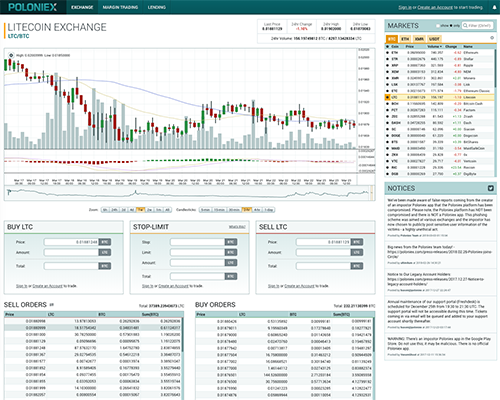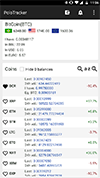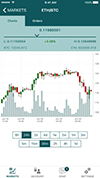

Poloniex is a crypto-to-crypto global exchange operating in the US. It registered with the Financial Crimes Enforcement Network (FinCEN) as a money service business (MSB) on August 29, 2016. However, it has been in operation since January 2014.

9.2
iOS: 3.5
Android: 3.5



 Margin tradingYes (Exchange support margin trading)
Margin tradingYes (Exchange support margin trading) Trust scoreA
Trust scoreA Beginner friendlyNo (Exchange is complex and difficult for beginners)
Beginner friendlyNo (Exchange is complex and difficult for beginners) Stability4. Very (Exchange is very stable)
Stability4. Very (Exchange is very stable) FiatNo (The Exchange does not support Fiat currency like USD, EUR, etc ...)
FiatNo (The Exchange does not support Fiat currency like USD, EUR, etc ...) Support speedFew week (Technical support is slow to respond within a few weeks)
Support speedFew week (Technical support is slow to respond within a few weeks) SafetyA (Very secure)
SafetyA (Very secure) APIYes (API is available for public to use)
APIYes (API is available for public to use) Rest APIYes (The Exchange has Rest API support)
Rest APIYes (The Exchange has Rest API support) WebsocketYes (The Exchange has Websocket support)
WebsocketYes (The Exchange has Websocket support) Mobile appYes (Exchange has a mobile app)
Mobile appYes (Exchange has a mobile app) Credit cardNo (Exchange does not support credit cards)
Credit cardNo (Exchange does not support credit cards) ReferralNo (Exchange does not offer an affiliate program)
ReferralNo (Exchange does not offer an affiliate program) Two factor authentificationYes (The Exchange supports two factor authentication)
Two factor authentificationYes (The Exchange supports two factor authentication) Verification timeFew Weeks (The Exchange verifies the user within a few weeks)
Verification timeFew Weeks (The Exchange verifies the user within a few weeks) LendingYes (Exchange support lending)
LendingYes (Exchange support lending) Stop limitYes (Exchange supports stop limit)
Stop limitYes (Exchange supports stop limit) US licenceNo (Exchange don't have US licence for Money transmitter)
US licenceNo (Exchange don't have US licence for Money transmitter) PGP supportNo (Exchange does not have PGP encryption)
PGP supportNo (Exchange does not have PGP encryption)While the bureau lists the location of exchange’s offices in Wilmington, Delaware, research shows the address belongs to an agent. Little information is available online—including on the company’s website—about ownership. On LinkedIn and company profiling website Owler, someone named Tristan D'Agosta identifies himself as the founder and CEO of Poloniex. According to information he shares on these pages, D’Agosta is a music composer and a former freelance writer with a Bachelor of Arts in music from Rutgers University.
Advantages of Poloniex
- World's largest Ethereum exchange (by average volume in 2017)
- Go-to place for serious crypto traders seeking new & trendy coins for speculation.
- Provides extremely detailed charts, as well as efficient data-analysis tools
- Most trading interface code is executed client-side & therefore open source for enthusiasts to examine
- Offers a high-volume margin trading & lending service for major crypto assets, on top of an exchange platform
- Its services are accessible from anywhere on the globe
- Supports over 70 popular digital assets, among the highest number in the industry
- Charges low crypto deposit and withdrawal fees compared to other exchanges
- Fully refunded affected users after a minor security breach
- Community representatives are active answering questions and hearing feedback on social media
Disadvantages of Poloniex
- Since May 2017 we are seeing some unconfirmed reports of users not being able to withdraw funds from Poloniex
- Private key management is centralized, exposing funds to custodial risks. See Bisq for a decentralized alternative.
- The inability to deposit fiat currency excludes all users wanting to use Poloniex to "on-ramp" into crypto.
- The customer support ticketing system is poor and sometimes non-existent
- The identities of managers and investors are unknown. No community interviews given so far.
- No known physical offices. Perhaps a security precaution - but still a big negative for trust.
- Increasingly requiring users to create accounts and verify their identity for high-volume activity.
- Recent downtime & slowness issues throughout the 2017 crypto boom.
- Trollbox open chat system recently deactivated. Though this has helped reduce price manipulation through the spreading of misleading information.
Manuals for Poloniex
Signing up for an account on Poloniex is easier than on most other major digital asset exchanges. While it observes some level of Know Your Customer requirements, the process is less stringent partly due to the fact that the exchange accepts only crypto deposits.
Users are only allowed one account, and registering more than one could result in suspension or expulsion from the platform. Each account, however, offers exchange, trading and lending services. You automatically have access to all three services when you sign up for any of them.
The exchange service facilitates the movement of value from one crypto to another. On the other hand, the margin trading service enables you to leverage your cryptos and earn gains from price changes.
If you are risk averse but still want to make a profit on the platform, you can put up your cryptocurrencies for others to borrow and trade with. In exchange, you will receive a guaranteed interest rate.
When you engage in margin trading, you essentially have access to the three sections available on Poloniex. You access exchange, a margin trading and a lending/borrowing section. You can borrow funds from the lending section to invest through the margin trading section.
In the event you want to move your value to another type of crypto, you will need to use the classic exchange section. It is also through the exchange section that you make deposits.
When compared to trading platforms such as Coinbase’s GDAX, or Bitstamp/Kraken, I feel that Poloniex is the easiest to start using. Once your signup is complete (this takes less than five minutes) you are ready to deposit and start trading. The most differentiating feature from the rest of the trading platforms, however, is the fact that Poloniex offers more risk-averse crypto holders the option of lending out their coins.
Security rating of Poloniex
As with all centralized exchange audits, I would like to remind readers of this Poloniex review that the exchange controls all private keys to the wallets holding your cryptocurrencies. The exchange assures users that it stores much of their deposits in offline "air-gapped" cold storage. It offers 2-factor authentication for account holders, as well as browser recognition tools.
While Poloniex’s promises of security may be based on sound capacity, users must trust that the measures in place are tight enough and that individuals in charge of funds are honest.
In 2014 the exchange suffered a minor security breach where 12% of all customer bitcoin deposits were stolen. In an unprecedented move (at the time), a statement was issued assuring users that all funds would be reimbursed. Poloniex carried through their promise to its users several months later.
As the Bitcoin project itself has shown, lack of information about a founder is not always a sign of bad intent. However, as a precaution, it is advisable to keep on the exchange only as much value as you need to lend, trade or exchange at any given time, especially considering Poloniex is a centralized platform with a high custodial risk.
As with all centralized exchanges, you should always send whatever funds you don’t immediately need on the platform to a wallet you control.















